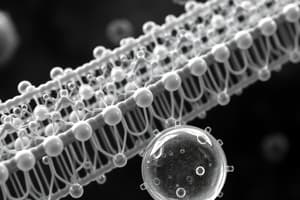Podcast
Questions and Answers
What is selective permeability?
What is selective permeability?
Selective permeability means that a barrier allows some substances to pass through it while excluding others.
What is the process by which molecules tend to scatter themselves through available space?
What is the process by which molecules tend to scatter themselves through available space?
Diffusion
What do we call the unassisted diffusion of solutes through a selectively permeable membrane?
What do we call the unassisted diffusion of solutes through a selectively permeable membrane?
Simple diffusion
What is facilitated diffusion?
What is facilitated diffusion?
What is osmosis?
What is osmosis?
What is active transport?
What is active transport?
What is passive transport?
What is passive transport?
What is solute pumping?
What is solute pumping?
What is exocytosis?
What is exocytosis?
What is endocytosis?
What is endocytosis?
What does phagocytosis mean?
What does phagocytosis mean?
What is pinocytosis?
What is pinocytosis?
Hypertonic solutions have fewer solutes than those inside the cells.
Hypertonic solutions have fewer solutes than those inside the cells.
Hypotonic solutions have more solutes than the cell does.
Hypotonic solutions have more solutes than the cell does.
Isotonic solutions have the same solute and water concentrations as cells.
Isotonic solutions have the same solute and water concentrations as cells.
Study Notes
Selective Permeability
- Selective permeability allows specific substances to pass while blocking others, facilitating nutrient entry and waste elimination.
- Valuable proteins and other essential substances are retained within the cell.
Diffusion
- Diffusion refers to the scattering of molecules or ions through available space.
- Simple diffusion occurs without assistance, allowing lipid-soluble or small molecules to pass freely through the plasma membrane.
- Facilitated diffusion involves specific carriers aiding in the transport of larger or lipid-insoluble substances.
Osmosis
- Osmosis is the diffusion of water across a selectively permeable membrane.
- It plays a crucial role in maintaining cell homeostasis.
Active Transport
- Active transport requires ATP energy to move substances against their concentration gradient across the membrane.
- Essential for nutrient uptake and waste removal when passive processes are insufficient.
Passive Transport
- Passive transport involves the movement of substances across the membrane without cellular energy expenditure.
- Relies on concentration gradients for the natural flow of molecules.
Solute Pumping
- Solute pumping utilizes ATP to power protein carriers known as solute pumps, crucial for moving ions and molecules across membranes.
Exocytosis
- Exocytosis transports materials out of the cell, including hormones and waste products.
- This active process is vital for cellular secretion and waste management.
Endocytosis
- Endocytosis encompasses ATP-dependent processes for engulfing extracellular substances in vesicles.
- Essential for nutrient uptake and cellular signaling.
Phagocytosis
- Phagocytosis, or "cell eating," involves scavenger cells ingesting bacteria, dead cells, and debris to protect the body.
- Primarily performed by specific white blood cells.
Pinocytosis
- Pinocytosis results from the invagination of the plasma membrane, forming vesicles to absorb extracellular fluid with dissolved nutrients.
- Important for nutrient acquisition in cells.
Hypertonic Solutions
- Hypertonic solutions contain more solutes than the interior of red blood cells, leading to cell shrinkage (crenation).
- Causes an imbalance that dehydrates cells.
Hypotonic Solutions
- Hypotonic solutions have fewer solutes compared to the inside of cells, resulting in swelling and potential bursting of cells due to water influx.
Isotonic Solutions
- Isotonic solutions maintain equal concentrations of solutes and water compared to cells, causing no observable changes in cell size or function.
Studying That Suits You
Use AI to generate personalized quizzes and flashcards to suit your learning preferences.
Description
This quiz focuses on key concepts in cell transport, including selective permeability, diffusion, facilitated diffusion, osmosis, and active transport. The questions are based on specific pages and figures from the textbook. Test your understanding of how substances move across cell membranes.




